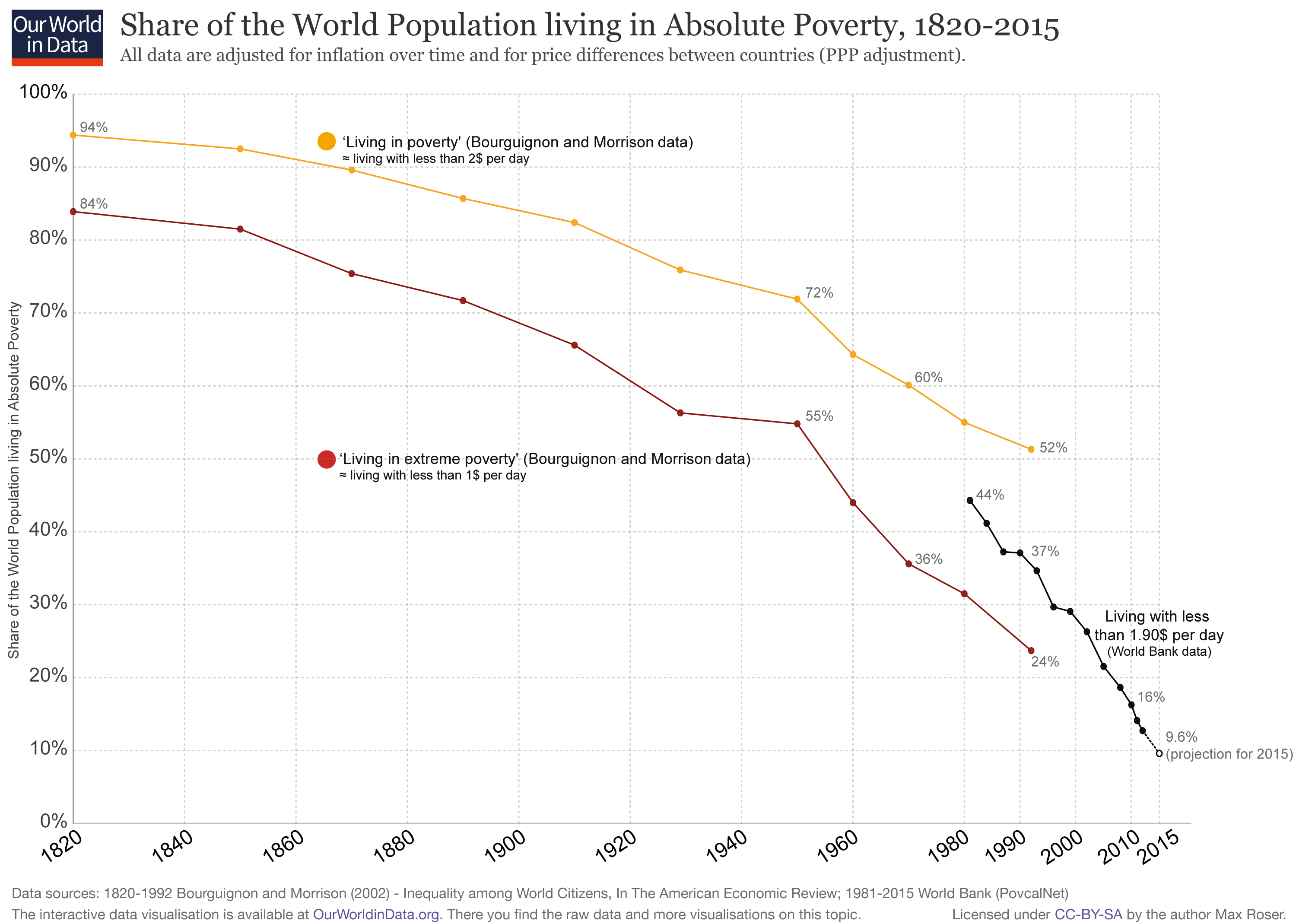Good News for Wednesday: The World is Getting Better
by meep
But you don’t have to take my word for it.
When I published Abundance: The Future is Better Than You Think in February 2012, I included about 80 charts in the back of the book showing very strong evidence that the world is getting better.
Over the last five years, this trend has continued and accelerated.
This blog includes additional “Evidence for Abundance” that you can share with friends and family to change their mindset.
We truly are living in the most exciting time to be alive.
By the way, if you have additional ‘Evidence for Abundance’ (charts, data, etc.) that you’ve encountered, please email them to me at data@diamandis.com.
But wait — some of his stats are stale! I can fix that!
FEWER LIVING IN ABSOLUTE POVERTY
Via Our World in Data, which has a section on poverty.
Here’s his most recent graphs on absolute poverty:

More people living better than before.
FEWER CHILDREN DYING
Now he looks at child mortality (deaths under age 5).
The last report came out with 2015 data, and here’s a graph I made from it:

That is the cumulative mortality rate, meaning that in 1990, 10% of children in the developing world did not make it to their 5th birthday.
By 2015, that death rate had halved.
That’s amazing.
And heck, even in the developed world, the mortality rate decreased by more than 50%! And it wasn’t particularly high to begin with.
U.S. CHILD MORTALITY STILL IMPROVING
And while that’s great progress in 25 years, I have a different graph to show you:

Data are via Gapminder.
And that’s child mortality for the United States. Almost half of children born in 1800 didn’t make it to age 5. And now fewer than 1% don’t make it. That’s a 99% improvement in 215 years. But it wasn’t even over all those 215 years.
See the two blips?
1880 was a diphtheria outbreak, which mainly killed children.
1918 was the infamous Spanish flu pandemic, which killed across age groups, but hit young adults especially hard.
Anyway, the vaccines we get now are no joke. Pretty much all the diseases we give vaccines for can kill people, and have often killed the very young.
But not as much anymore.
But let’s look at the decadal improvement. I’m going to do this by decades (ending on 2010), and taking the percentage improvement. So a 10% improvement means a 10% decrease in the mortality rate over the decade.

The 19th century was a rough time to live (or, in this case, not live). While there was some mortality improvement for children up til the Civil War, that diphtheria outbreak caused disimprovement.
But check out 1930. From 1920 to 1930, there was an almost 50% improvement of mortality. Not a 25 year period, but a 10 year period. Child mortality dropped from about 17% to 9% over that period.
What happened in the 1920s?
Let’s check out the history of vaccines:
1921: William Park takes a campaign to get kids tested and vaccinated or treated for diphtheria.
1922: Supreme Court upholds vaccination requirements at public schools
1925: Balto and the diphtheria outbreak in Alaska
1926: MetLife has a large anti-diphtheria campaign in New York, spending $15K. That’s approximately equal to $200K today. Not millions, but still a decent amount of money.

Note that diphtheria antitoxin had been developed decades before, but it seems the 1920s was when they were really getting effective.
It probably wasn’t just diphtheria treatment that led to that great improvement, but it looks like the 1920s kicked off decades’ worth of vaccine development as well as the discovery of sulfa drugs and antibiotics. Some of the medical improvements came from lessons learned in the fields of WWI and WWII.
MORE GOOD NEWS
I’m about tuckered out with all this statistics-ing. But it is amazing how we keep getting improvements in mortality, even with relatively low rates today.
I have noticed that many people look younger than predecessors at the same age, and I don’t think it’s due to plastic surgery — much of it is due to less smoking, better nutrition (yes really), less childhood diseases, and better teeth. All of these help people look younger.
Okay, being fat can also round out the face. ;)
But hop over to Diamandis’s post for some non-mortality good news.
Related Posts
Deaths from Heat and Cold: Deception and Update for U.S. 1999-2022
Motor Vehicle Accident Deaths, Part 2: Age-Related Trends with Provisional Results in 2021
Retirement Crisis Solution: Kill the Elderly
